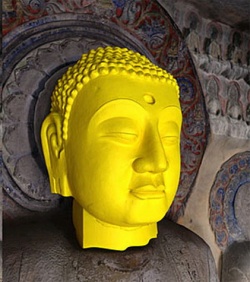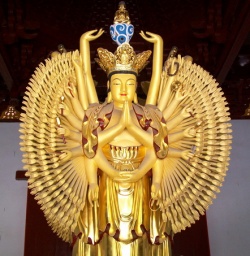Buddhism in China
The first Buddhist parishes are found in China in the 1st century AD and focused mainly on the suppression of passions by means of meditation, charity and compassion. The monastery claiming to have been the first in China is the White Horse Monastery (Baimasi 白馬寺) near Luoyang. Many similarities with Taoism made Buddhism look like another sect of Huang-Lao-Taoism; both religions have no sacrificial ritus, believe both in immortality and operate with concentrationn and abstinence. The early translations of Buddhist sutras all used Taoist terms to paraphrase the complicated construct of Buddhist metaphysical philosophy, like dao 道 for dharma, bodhi, yoga, or zhenren 真人 as arhat, wuwei 無為 as nirvana, and ming 命 as karma. Later translators were more cautious in translating Buddhist terms and sometimes did not even dare to translate it. Nirvana was simply transscribed as niepan 涅盤, abhidharma as apidamo 阿毘達摩. Experienced tranlators of Tang Dynasty finally were able to define exact terms of translation: ji 寂 and lun 論, in our example.
The first great time of Buddhism in China was during the Eastern Jin Dynasty, when the new religion entered the gentry class. Disappointed and not more interested in governmental officials, the landowning class joined the Buddhist community. But also scholars, that were more interested in Taoism since the end of the Later Han Dynasty, became fond of the new religion, that gave both groups a stronghold in a time of ceaseless war. The Non-Chinese rulers of the Northern Wei Dynasty converted to Buddhism and saw themselves as personification of the Buddha. The maturity and great age of Buddhism in China was the Tang Dynasty when emperors spent their wealth to establish monasteries and sculptures in different Buddhist caves. But this age was not free of persecution, especially by Confucian oriented statesman that wanted to get rid of the foreign religion. Many people converted and entered a monastery to escape military service and tax paying. The revival of Confucianism under the Song Dynasty caused the decline of Buddhism as a state religion. But as popular belief, Buddhism is still very widespread, but highly mixed with Taoist belief.
The transition of the foreign religion into a Chinese one was made easy especially by the ideal of charity and compassion of Great Vehicle Buddhism. Both terms are quite similar to the Confucian idea of filial piety and the compassion of the ruler for his subjects. Other concepts of Buddhism are quite contrary to Confucianism (suffering - enjoying; celibacy - family; mendicant monks - productive farmers; monastic community - subordination under the state), but the missing of a central power during the 3rd and 4th centuries gave room for the Buddhist religion of salvation of the individual. The power of spells and charms had a great attraction not only to Chinese peasants, but also for the foreign rulers in the north. Finally, many people escaped military service and tax duty by entering a monastery. Looking at Confucianism, we see that this state doctrine is totally lacking the aspect of the spiritual world (except ancestor veneration), and it is quite understandable that people found a good way to meet their religious needs in Buddhism.
Buddhism and its representant objects became part of the Chinese culture like dragons and chopsticks. The Laughing Buddha ("Pot-Belly Buddha") is the transformation of an Indian askete into a deity objecting Chinese ideals. The Indian stupa, a small buildings that contains relics of the Buddha or his scholars, and at the same time symbolizing the center of the Indian universe, mount Meru, became the Ceylonese dagoba, the Thai chedi, the Tibetian cherten (the most beautiful being erected in Katmandu/Nepal), and finally the Chinese nine-floor pagoda (ta 塔).
The practice of Buddhism spread in the centuries after the death of Gautama Buddha through the actions of pilgrims, wandering evangelists, and strong believers who wished to spread the faith to remote lands and also through observation of Buddhist practices by those who traveled overseas from India and Sri Lanka.
The various routes that composed [[The Silk Road]] were important conduits for Buddhism making its way into China, more so than the maritime routes that were more influential in the transmission of the belief into Southeast Asia.
Buddhism was recorded as being present in China from the time of the Han dynasty, and according to legend, the emperor Mingdi (Ming-ti , 57–75 c.e.) received a divine vision that inspired him to seek out knowledge of The Buddha from India.
Chinese monks and scholars were dispatched at regular intervals to seek out Indian knowledge and texts that could be brought back to China and translated into the Chinese language. In nearly every case, when Buddhist concepts were introduced to China they were combined with preexisting Chinese religious concepts or else were subsequently modified.
Notably, Buddhism was combined with the Daoist (Taoist) philosophy of Laozi (Lao Tzu), both to show respect to the latter and also to make the new, foreign concepts more intelligible to a Chinese audience.
The sheer size and degree of diversity within China meant that variations in interpretation inevitably occurred. Since most Chinese Buddhists had little knowledge of Pali or Sanskrit, the rituals in which all monks recited in unison the accepted Buddhist canon had less effect than it did in India.
At times Buddhism was suppressed as a foreign religion that was interfering with native Chinese beliefs. Forced underground during such periods, the rate at which variations in philosophy developed accelerated because of difficulties in communicating with other communities of believers. A number of different schools of Buddhist thought have consequently emerged in China.
Tiantai
Tiantai Buddhism was founded on Mount Tiantai in southeastern China by the Monk Chiyi (Chih-I, 538–597 c.e.), during the Sui dynasty. It focused on the Lotus Sutra (Saddharmapundarika-Sutra, or Fahua-ching in Chinese) as its central text. The Tiantai school taught that existence was real but impermanent and insubstantial and the need to adhere to the middle path in the search for personal Enlightenment.
Chiyi’s belief was that Sakyamuni knew the entire canon of Buddhist thought at the time of his Enlightenment, but it has only subsequently been released into human awareness because of the inability of people to comprehend the entirety of the message. Tiantai Buddhism was introduced into Japan at the beginning of the ninth century under the name Tendai by the Monk Saicho.
Huayan
The Avatamsaka school of Buddhist thought is known as Huayan in China and Kegon in Japan. It is based on the Avatamsaka-Sutra, which is also known as the Garland Sutra or Wreath Sutra.
Huayan Buddhism is associated with the Monk Fazang (Fa-tsang, 643–712 c.e.), also known as Xianshou (Hsien-shou), the third patriarch who did much to develop the lessons of the school. The basis of Huayan Buddhism is that all elements of reality depend on each other and arise because of each other, spontaneously.
At every moment an infinite number of possibilities exist, and it is possible, therefore, for an infinite number of Buddhas (who can internalize all of the possible variations within a harmonious whole) to emerge into the world. Advanced training of the mind and meditation are necessary to be able to comprehend the nature of reality and of how to strive for Enlightenment.
Fazang was born into a Sogdian family from Chang’an (Ch’ang-an), and the system he established is often regarded as one of the most advanced and complete of all the schools of Buddhism to be created in China. It continues to be influential in Japan even in the modern age.
In China itself the Huayan form lost popularity as a result of the general suppression of Buddhism during the later Tang (T’ang) dynasty. It reemerged in part in the fostering of Neo-Confucianism, which flourished from the 11th century c.e.
Pure land
The Pure land form of Buddhism, known in Chinese as Qingtu (Ching-tu), is based on the Pure land Sutra (Sukhavativyuha-Sutra), which was created in the north of India in the second century c.e.
The Sutra concerns the process of a Monk who sought Enlightenment by, in part, vowing to create a Pure land in which all could live happily to a long and fulfilled age. Those who practice Pure Land Buddhism commit themselves to various vows that are believed to help them achieve Enlightenment.
The 18th vow in particular is significant and holds that pronouncing the name of The Buddha at the point of death is sufficient to ensure that the soul will be reborn in the Pure land. This form of Buddhism became very popular, largely because it offered the opportunity for ordinary people to aspire to Enlightenment within their own lifetime.
The belief is that the Monk in the Pure land Sutra, whose name was Dharmakara, did achieve Enlightenment and now resides in the Pure land in the form of The Buddha Amitabha, or, in Chinese, O-mi-to-fo. There, together with the goddess Guangyin (Kuan yin) and Mahasthamaprapta, he assists humans to achieve their goal of being reborn in the Pure land.
Clearly the teachings of Pure Land Buddhism diverge considerably from the other forms of Buddhism taught in the past. Instead of the historical Buddha’s insistence that only what can be personally evaluated and experienced can be used in the struggle for Enlightenment, which is the single ultimate goal of human existence, people can rely on the benevolence of the trinity led by Amitabha and have as an ultimate goal Rebirth in the paradise of the Pure land.
Zan
Zan Buddhism focuses on the role of meditation in the search for Enlightenment. It is known as Dhyana Buddhism in Sanskrit and zen in Japan, where it reached its greatest level of popularity. The Indian Monk Bodhidharma brought it to China in 520 c.e.
Zan Buddhism is centered on the belief that all living creatures have within themselves an aspect of Buddhahood and that it is possible, through intensive meditation, to realize this existence, which results in wu, or Enlightenment.
Similar to the teaching of the historical Buddha, it teaches that the realization of the presence of the internal Buddha aspect can by no means be taught or explained by anyone else but can only be appreciated through internal cultivation of consciousness.
An intensive regimen of meditation was not something that many people had the opportunity to pursue, which is one reason why the Pure land school achieved a greater level of popularity. After the death of the fifth patriarch of the Zan school, a split occurred between northern and southern adherents.
The southern tendency, which was named after Huineng (Huineng), taught that Enlightenment through meditation could be achieved much more swiftly and immediately than was proposed by the northern tendency. Huineng was more successful than the gradualist approach of the northern school, which eventually disappeared from China.
The coming of Buddhism to China from Indian was a great event in the development of Chinese culture and of Buddhism itself. After a long period of assimilation, it established itself as a major system of thought as well as a religious practice, contributing greatly to the enrichment of Chinese philosophy and exercising and enduring influence on the Chinese popular religion and on the mind and character of the Chinese people. Indeed, it becomes one of the Three Pillars of the traditional culture of China.
Buddhism was firstly introduced into the region inhabited by the Han people around the 1st century. It is said that in the year 2BC, Yi Cun, an emissary of Dayuezhi Kingdom (an ancient mid-Asian country established by a strong Chinese minority originally living in northern China and later moved to the west), went to Chang'an (today's Xi'an City) to impact Buddist sutras to a Chineses Doctor Jing Lu. And this is the first record about the Introduction of Buddhism into China.
There is another saying that during the reign of the Indian King Asoka (272-226 BC), 18 Indians visited China’s Xianyang City during the reign of Emperor Qin Shihuang. In the year 250BC, King Asoka convoked the third conference and, after the conference, Dade was sent to spread Buddhism to other countries including China.


